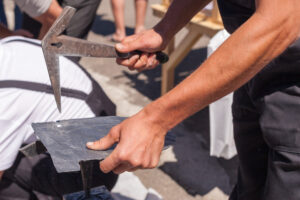Our Blog
Why you need a master slater for your new roof
If you have chosen to have a slate roof installed, there are many aspects of the project you need consider before you choose a roofing contractor. Installation of slate roofing is not straightforward, and many companies who claim they can mount a slate roof do not have the expertise and experience to do the job well. A master slater is required.

Here are some of the things to watch out for when you start getting quotes:
- The right underlay sheathing
This is crucial because the underlay on the roof must be able to last at least 150 years. Remember, slate roofs are very durable and can still be in good condition even after 300 years with regular maintenance. Laminated woods, plywood, and particle board are not appropriate decking materials for slate roofs.
If you want your slate roof to last, or if you are undertaking repairs and renovation, the underlying deck should be solid boards, not glued or laminated wood. A reputable, experienced and skilful installer will know this and will advise you in great detail.
- Guard against the possibility of leaking
Two things keep water from leaking through slate rooves: the type of slate used and the flashing. There are many different types of slate sourced from all over the world. The best is Welsh Penrhyn from the UK. Canadian Glendyne and Spanish Pizarras slates are also top of the range in quality and durability so make sure you ask for these types of slate for your project. Unfortunately, many architects are uninformed, and some recommend other varieties of slate which are much less robust, and cheaper.
Not only must the flashing be of a suitable type and gauge, but it must also be installed correctly. Copper or lead flashings are the most durable and although expensive are vital components in preventing leaks. No one should walk on the slate at any time. The roof needs to be installed in stages, using roof ladders and specialised scaffolds. If the contractors walk on the roof during installation, this can give rise to problems with leakage later. Master slaters know how to install slate correctly with no mishaps, and they will never walk on a slate roof during installation or repair.
- The equipment used
Installing slate is very close to skillful stone masonry work in practise, and the tools needed for slate roofing are very different from the tools used for other roofing materials.
Tools for trimming slate tiles, especially for the valley areas, copper nails, rippers, hammers, cutters, and stakes are all essential to the process and do not feature in the laying of other roofing materials.
Installing slate is a specialized skill requiring a long apprenticeship and intensive training, and often the finer points of this expertise are passed down on-the-job from generation to generation.
Slate roof installation and slate roof repairs are not a DIY process, and you need to choose a qualified and highly professional company to do this work.
Master slaters are a rare breed; they stand apart from other roofing contractors because of their high-quality training.
In Sydney, there are only very few companies who have slate roofing expertise, so make sure your contractor has the right qualifications and license, with well-trained workers. Finally, ensure that you have every aspect of the project explained to you in full before work starts.